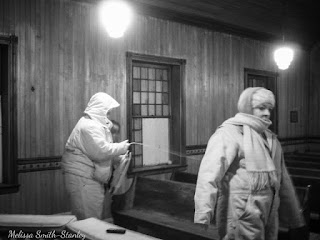 Bruce Chapel Church was built in 1842 and was the first Episcopalian church in Mason County, West Virginia. The church was built on land that was sold by the Moore and Stephens families. The church was named for Eliza Bruce, for her charitable contributions to the church.
Bruce Chapel Church was built in 1842 and was the first Episcopalian church in Mason County, West Virginia. The church was built on land that was sold by the Moore and Stephens families. The church was named for Eliza Bruce, for her charitable contributions to the church.The church sits on a hillside and located on the adjacent property is a cemetery which has graves dating back to at least the 1840's. There are several unknown graves only marked with fieldstones and likely some slave burials exist here as well. Some slave burials are believed to be underneath the newer back addition of the church.
 I first came learn about Bruce Chapel in 2006 during my search for haunted locations in West Virginia. I had just started a paranormal group and was seeking some places we might be able to investigate. The information included a nearby location known as the Mai Moore Mansion. The old Mansion, which was once located near the church, was believed to have been built around the time of the Civil War, it was home of Charles Page Thomas Moore and family. The house burned down in 1960s. The Moore family members are buried at Bruce Chapel Cemetery.
I first came learn about Bruce Chapel in 2006 during my search for haunted locations in West Virginia. I had just started a paranormal group and was seeking some places we might be able to investigate. The information included a nearby location known as the Mai Moore Mansion. The old Mansion, which was once located near the church, was believed to have been built around the time of the Civil War, it was home of Charles Page Thomas Moore and family. The house burned down in 1960s. The Moore family members are buried at Bruce Chapel Cemetery.I have never been able to locate the exact location of the remains of the Mai Moore Mansion. The mansion is within the vicinity of the church, up on a hill, so we have been told. The area is likely on private property and was told by a local that there were several cisterns around the ruins, posing a hazard to any explorers. The old mansion was also located near a large prehistoric Adena burial mound known as the May Moore Mound. The mound was named for Charles Moore's daughter. Today, the mound is located on private property and lies near the Ohio River, there are also several other smaller mounds said to be in the area.

Bruce Chapel is a known haunted location to many. I have come to believe that the claims are potentially true. The possible burials under the church, the local family connections to the church and graveyard, and even the proximity to the Adena burial mounds could have contributed to the stories. However, I wouldn't claim this rumor might be true unless I had experienced for myself.
In 2006 my team went to check out the church and cemetery for the first time. What we found was an abandoned church with a slightly overgrown cemetery. It was daylight, it was summer, it was hot,
and the bugs were biting. We were recording, hoping to catch EVPs right at the front door, and upon review we captured a voice that was not anyone that was with us.
In 2012, the team secured permission to investigate inside the little rural church. It had a new owner and they were starting the process of restoration work. It was bitter cold, 17 degrees, snow on the ground, no heat in the church and bull running loose in the area. We had a really quiet evening, thankfully, until I reviewed the photos. As we were packing up, I snapped some final photos and I captured something that I cannot explain even 8 years later. It may be something, it may be nothing.
The bottom photo was taken with a point and shoot IR camera. It looks as though something, or someone is peeking around my friend who is winding up cord from our video cameras. Again, I don't claim it is paranormal but you are welcome to draw your own conclusions.
Photos on this site are property of Melissa Stanley unless otherwise noted. Photos on this page were all taken in 2012.




No comments:
Post a Comment